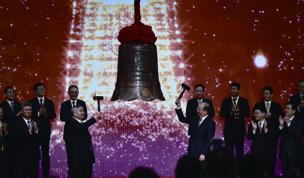2020’s Top 10 Business News Stories

1 Economy Gains Positive Growth
Despite the impact of the novel coronavirus disease (COVID-19), the Chinese economy is projected to achieve positive growth in 2020. China will grow by 1.9 percent, the only major economy that could see growth this year, the International Monetary Fund forecast in its latest World Economic Outlook report on October 13.According to the National Bureau of Statistics (NBS), the first three quarters registered a 0.7-percent growth year on year. The GDP is expected to exceed 100 trillion yuan ($15.3 trillion), as per the communiqué of the Fifth Plenary Session of the 19th Central Committee of the Communist Party of China (CPC) issued in October.
Besides effective control of the epidemic and rapid resumption of production in various sectors, the results are also attributed to new growth drivers including the emerging industry of e-commerce and live-streaming. The construction of new infrastructure such as 5G networks, extra-high voltage power grids, inter-city rail transit, new-energy vehicle charging stations, big data centers, artificial intelligence (AI) and the industrial Internet has also played a crucial role.
2 A Bumper Harvest
The grain output reached nearly 670 million tons in 2020, up 5.65 million tons from last year, shoring up food security and boosting efforts to eradicate absolute poverty by the end of the year. It is the 17th consecutive bumper grain year with the output up 0.9 percent year on year, the NBS said on December 10.Though farming was disrupted by COVID-19 and severe floods, the abundance came thanks to policies to ensure the transportation of agricultural materials and strengthened farming management.
3 Online Trade Fairs
Going online became an effective solution for trade fairs this year against the backdrop of COVID-19. The online format of major expos provided an alternative in this special period, reflecting the backbone role played by innovative technologies such as 5G, live-streaming and online translation, as well as surging market demand.The spring edition of the China Import and Export Fair, or the Canton Fair, was held online in June, a first in its 63-year history. Other major expos such as the China International Fair for Trade in Services in Beijing and the China International Fair for Investment and Trade in Xiamen, Fujian Province in the southeast, in September, and the Third China International Import Expo in Shanghai in November had both actual-virtual and offline-online versions.

4 Higher-Level Opening Up
Though economic globalization faces headwinds, China has remained steadfast in easing market access for foreign firms and fostering a world-class business environment.The Foreign Investment Law, which took effect on January 1, will better protect the interests of investors.
For pilot free trade zones (FTZs) that enjoy a higher-level opening up, the negative list spelling out restricted sectors for foreign investment now contains 30 items, reduced from 37. For non-FTZ areas, the number is down to 33 from 40. The updated lists announced by the National Development and Reform Commission and the Ministry of Commerce came into effect on July 23.
China saw a 6.3-percent increase in paidin foreign investment in the first 11 months this year, reaching 899.38 billion yuan ($129.4 billion).
5 Master Plan For Hainan FTP
As another step in promoting opening up, a master plan for the Hainan Free Trade Port(FTP) was released by the CPC Central Committee and the State Council on June 1. The southernmost island province will be built into a globally influential high-level FTP by the middle of the century.By 2025, a basic FTP system focusing on trade and investment liberalization and facilitation will be established and by 2035, it will become more mature, according to the plan.
6 Rise of IC Industry
Policies including tax incentives were unveiled on July 27 to accelerate the development of the integrated circuit (IC) and software industry. The aim is to enhance innovation capabilities and development of domestic companies.This is a key step to attain self-sufficiency in the chip industry especially in view of likely disruptions due to the outgoing U.S. administrations ban on selling chips to China.
Select IC producers with an operating period of more than 15 years are exempt from corporate income tax till their 10th year.
7 Registration-Based IPOs Debut
The first batch of registration-based initial public offerings (IPOs) of 18 enterprises debuted on August 24 on the ChiNext Board, Chinas NASDAQ-style board of growth enterprises at the Shenzhen Stock Exchange, marking a milestone for the countrys capital market reforms.Adopted in June, this is a reform of the earlier approval-based system, which required a review by a committee and had a higher threshold.
After more than a decade of growth, over 800 companies are listed on the ChiNext, with a market value of more than 9 trillion yuan ($1.37 trillion).
The registration-based IPO system was first tried on the Shanghai bourses STAR Market in June 2019.
8 Hualong One Reactor Connected to Grid
The first nuclear power unit using the Hualong One technology, Chinas domestically developed third-generation reactor design, was connected to the grid on November 27.The successful connection to the grid will improve the competitiveness of Chinas nuclear power industry, optimize the power structure and promote green and low-carbon development. The unit in Fuqing in the southeastern province of Fujian will undergo a series of tests and trial runs before it starts commercial operation.
The China National Nuclear Corp. and China General Nuclear Power Group jointly designed the Hualong One reactor, which passed inspection by a national panel in 2014.
9 Pilot Test of Digital RMB
On October 12, Shenzhen in the southern province of Guangdong announced the launch of a pilot program with the Chinese central bank to distribute 10 million yuan ($1.53 million) in digital money to the public.The money, distributed equally among 50,000 recipients through lottery, could be used at over 3,300 designated merchants. It marked a new phase for the digital renminbi to be test-used publicly.
On December 12, Suzhou in Jiangsu Province, east China, launched the second lottery to distribute 20 million yuan ($3.06 million) worth of digital renminbi to local residents.
According to a circular released by the Ministry of Commerce on August 14, digital currency and electronic payment (DC/EP) will be piloted in the Beijing-TianjinHebei region, the Yangtze River Delta, the GuangdongHong Kong-Macao Greater Bay Area, and some locations in central and western regions.
10 Stronger Fintech Regulation
With the rapid development of financial technology (fintech) and the digital transformation of financial institutions, financial services have become more efficient.As the off-counter transaction rate of Chinese banks has exceeded 90 percent and financial services are highly dependent on the Internet, cyber security needs to be highlighted, Guo Shuqing, Chairman of the China Banking and Insurance Regulatory Commission, said at a speech at the Singapore Fintech Festival held from December 7 to 12.
The number of Chinese peer-to-peer lenders had fallen to zero by midNovember from a peak of about 5,000, due to the crackdown on risky forms of financing.

